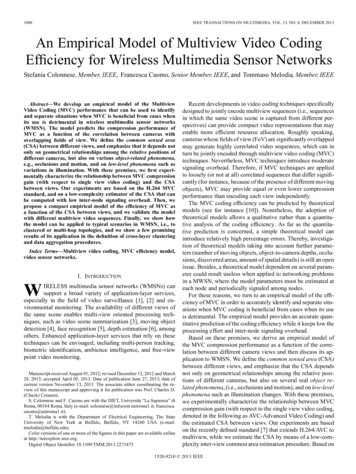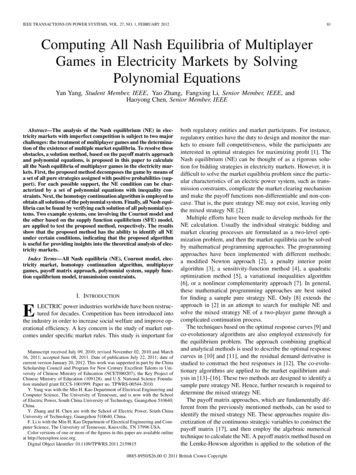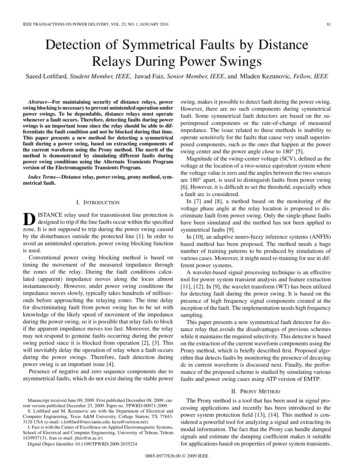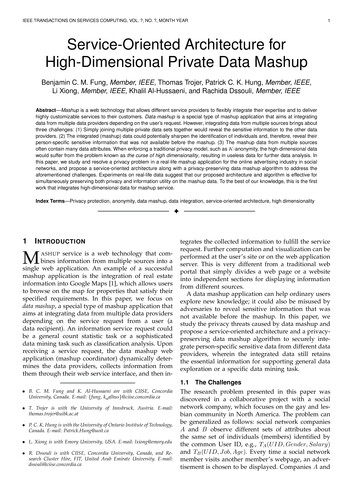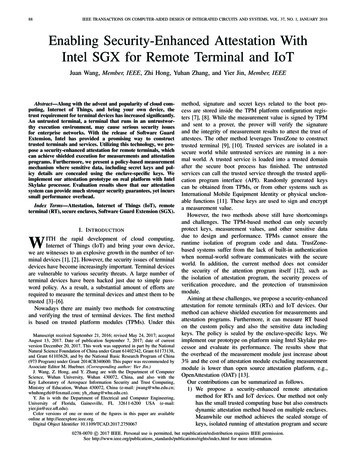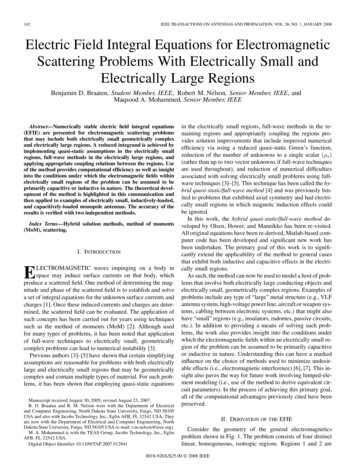
Transcription
IEEE TRANSACTIONS ON COMPUTERS, VOL. 14, NO. 8, AUGUST 20161High-Speed Modular Multipliers forIsogeny-Based Post-Quantum CryptographyJing Tian, Student Member, IEEE, Zhe Liu, Senior Member, IEEE, Jun Lin, Senior Member, IEEE,Zhongfeng Wang, Fellow, IEEE, and Binjing LiAbstract—As one of the post-quantum protocol candidates, the supersingular isogeny key encapsulation (SIKE) protocol deliverspromising public and secret key sizes over other candidates. Nevertheless, the considerable computations form the bottleneck and limitits practical applications. The modular multiplication operations occupy a large proportion of the overall computations required by theSIKE protocol. The VLSI implementation of the high-speed modular multiplier remains a big challenge. In this paper, we propose threeimproved modular multiplication algorithms based on an unconventional radix for this protocol, all of which cost about 20% fewercomputations than the prior art. Besides, a multi-precision scheme is also introduced for the proposed algorithms to improve thescalability in hardware implementation, resulting in three new algorithms. We then present very efficient high-speed modular multiplierarchitectures for the six algorithms. It is shown that these new architectures can be highly optimized and extensively pipelined to obtainhigh throughput thanks to the adopted overlapping processing scheme. The FPGA implementation results show the proposedmultipliers without the multi-precision scheme all achieve about 60 times higher throughput than the state-of-the-art design (the FFM2multiplier), and those with the multi-precision scheme all acquire almost 10 times higher throughput than this work. Meanwhile, each ofthe multi-precision based designs has almost the same resource consumptions as the FFM2 does.Index Terms—Modular multiplication, supersingular isogeny Diffie-Hellman (SIDH) key exchange, post-quantum cryptography (PQC),FPGA, VLSI.F1I NTRODUCTIONRecent improvements in quantum system control makeit seem feasible to finally build a powerful quantum computer in the near future [1]. Many companies like IBM,Google, and Intel have enthusiastically joined this field. Acompany named IonQ reported in December 2018 that itsmachine could be built as large as 160 qubits [2]. Theseachievements have actually brought to the flurry of research in public-key cryptography since most of the popularpublic-key ciphers, such as the RSA [3] and ECC [4] schemesbased on the difficulty of factoring integers or the discretelogarithm problem, can be solved by Shor’s algorithm [5]with quantum computers. Meanwhile, they have also accelerated the development in post-quantum cryptography(PQC) protocols. For example, the call for proposals for PQCstandards hosted by the National Institute of Standards andTechnology (NIST) [6] is driven by this demand.The supersingular isogeny key encapsulation (SIKE) protocol [7] has won the second round of fierce competitionsand been one of the 26 candidates in April 2019 after submitted to the NIST in November 2017. The possible reasonis that it is the only one which is similar to the classicalECC having very small public and secret keys and owningperfect forward secrecy. The core structure of SIKE is thesupersingular isogeny Diffie-Hellman (SIDH) key exchangeprotocol, packaged by the key encapsulation mechanism [8] J. Tian, J. Lin, Z. Wang, and B. Li are with Nanjing University, China.Email: jingtian@smail.nju.edu.cn, {jlin, zfwang}@nju.edu.cn, banxiabaisu@163.comZ. Liu is with Nanjing University of Aeronautics and Astronautics,China.Email: zhe.liu@nuaa.edu.cnDate of the manuscript: August 9, 2019.to defend against various side-channel attacks [9]. TheSIDH was first introduced by Jao and De Feo in 2011 toresist quantum attack based on the difficulty of findingisogenies between supersingular elliptic curves [10]. Thezero-knowledge identification scheme was proposed basedon this protocol in [11]. Jao and Soukharev presented theundeniable signatures based on the SIDH in [12]. In [13],Azarderakhsh et al. provided a key compression methodwhich brings in about twice of reduction in sizes of publicinformation without an impact on security. However, thecomputations of these algorithms are still huge and makethem encounter difficulties in practical applications.To alleviate this problem, many researchers have focusedon speed-up for the SIDH key exchange on hardware,like on FPGA [14], [15], [16] or on ARM [17], [18], [19].Through breaking down the computations, the modularmultiplication is one of the fundamental operations, whichis the main concerned issue in these designs. The first FPGAimplementation for SIDH key exchange was proposed byKoziel et al. in [14] by parallelizing the modular multipliersbased on the high-radix Montgomery multiplication algorithm [20]. They further sped up this protocol by addingmore modular multipliers in [15]. In [16], Liu et al. presented two fast modular multipliers, the FFM1 and FFM2,for SIDH based on an unconventional radix inspired bythe efficient finite field multiplication (EFFM) algorithmproposed in [21]. Additionally, the SIDH is implemented onARM-embedded systems as well. In [17], Seo et al. proposeda unified ARM/NEON multi-precision modular multiplication architecture based on the specialized Montgomeryreduction and integrated it to the SIDH library [22] toaccelerate the original ARM design. Jalali et al. implemented
IEEE TRANSACTIONS ON COMPUTERS, VOL. 14, NO. 8, AUGUST 2016the optimized field arithmetic operations on ARM for SIKEin [18] and commutative SIDH (CSIDH) protocols in [19],respectively. Indeed, much progress has been made to speedup the SIKE protocol and make it more practical. But, theseimplementations for this PQC candidate still suffer morethan one order of magnitude slower speed than those formost of the other candidates.Notice that the smooth isogeny modulus for SIDH 1has the form of p f · ax by 1, where a and b aresmall primes, x and y are positive integers, and f is asmall cofactor to make p prime. To simplify the modularoperations, especially for the modular multiplication, theparameter a is usually set to 2. The form of p then becomesf · 2x by 1. The EFFM in [21] uses the p with the form of2 · 2x by 1 2R2 1, where x and y must be even, andR 2x/2 by/2 , the input numbers of which are transformedinto quadratic polynomials based on the unconventionalradix R and about half of the multiplications can be reducedfor the reduction operation based on R at the cost of someadditions. The FFM1 in [16] reduces the coefficients of EFFMfrom three to two by using an extra mapping function for theinput and output, which could efficiently discard the precomputing constant without any increase in complexity. TheFFM2 in [16] extends the searching scope of the prime withthe form of f ·2x by 1 at the expense of more computations.It should be pointed out that a good prime could more possibly be found with a larger searching scope, which couldalso help increase the efficiency of the algorithm. Therefore,it is important to develop efficient modular multiplicationalgorithms with loose constraints for the prime.In this paper, we propose three new modular multiplication algorithms for different forms of prime based on anunconventional radix adopted in [16], [21], [23], and all ofthem have lower computational complexity than previousalgorithms. We aim to extend the previous prime usedin [21] into prime with form of f · 2x by 1 where f {1, 2},x and y are even. The prime can be split into three forms: 2 · 2x by 1, 2 · 2x by 1, and 2x by 1. Accordingly,the corresponding new algorithms are named as IFFM ,IFFMo , and IFFMe . We set x and y to even, and useR 2x/2 by/2 as the unconventional radix for the proposedalgorithms. For the IFFM algorithm, the usage of the radixis almost the same as before, which has been preliminarilypresented in our conference paper [24]. For the IFFMo and IFFMe , we use the radix R 2x/2 by/2 to reduce thecomplexity for the first time by expanding the range of theconstant coefficient of a quadratic polynomial. A detaileddiscussion can be found in Section 3.2. The reduction andmultiplication of the proposed algorithms are optimized toreduce the computational complexity by about 20%. Meanwhile, we also develop their multi-precision based versionswith a clever interleaving scheme and present three othernew algorithms to improve the scalability and reduce theresource consumption in hardware implementation.Moreover, we have devised new architectures for theproposed algorithms with fully parallelizing and overlapping schedules which enable to utmostly reduce the required clock cycles and highly optimize each sub-module.1. The SIKE has the same form of modulus; we mainly refer to theSIDH in the following discussion.2We have also coded the proposed architectures with theVerilog language and implemented them on FPGA. Theimplementation results show that the designs without themulti-precision scheme have about 60 times faster throughput than the state-of-the-art design by introducing a relatively small portion of extra hardware resources. Whenapplying the multi-precision scheme, these designs achievesignificant reductions on total resource consumptions atthe cost of slower throughput compared to their originalversions while still being much better than prior arts.2BACKGROUNDThe multiplication for cryptography is based on finite fields,called modular multiplication, requiring the modular reduction after the multiplication operation. In the following wewill first introduce the Montgomery reduction, the Barrettreduction, and the efficient Barrett reduction for the SIDH.Then, several efficient modular multiplications for SIDHwill be presented.2.1Modular Reduction Algorithms2.1.1 Montgomery ReductionThe main idea of the Montgomery reduction [25] is toreplace the ordinary modulus by a power of two so thatthe modular reduction operation is inexpensive to handle inhardware implementation. The detailed process is shown inAlg. 1. The modulus p is an arbitrary number, which is lessAlgorithm 1: The Montgomery reduction [25].Input: 0 c Rp, where R 2N and 2N 1 p 2N ;precompute p0 ( p 1 ) mod R.1: t ((c mod R)p0 ) mod R2: r (c t · p)/R3: if r p then4:r r p5: end ifOutput: r cR 1 mod p.than R (equal to 2N ). The term ( p 1 ) mod R is precomputed and saved. As integers modulo R is very easy, we willnot take this kind of computations into consideration in thefollowing counting. It can be found that the complexity isonly related to the bit width of the modulus p. This algorithm totally requires two N N multiplications, one 2N 2Nand one N N adders. Note that the output remainder isnot c mod p but cR 1 mod p. Luckily, if the operands areconverted into Montgomery presentations by multiplyingR, all of the arithmetic operations can be normally used.when an algorithm contains many modular multiplicationsand divisions, this conversion overhead becomes negligible.Therefore, the Montgomery reduction is usually used for theSIDH in conventional designs [14], [15].2.1.2 Barrett ReductionAnother hardware-friendly modular reduction algorithm is the Barrett reduction, proposed by Paul Barrett in1986 [26]. The key idea is also to transfer the complexdivision to an easier one by introducing an extra parameter.
IEEE TRANSACTIONS ON COMPUTERS, VOL. 14, NO. 8, AUGUST 2016Algorithm 2: The Barrett reduction [26].αN 1NInput: 0 c 2 ; 2 p 2 ;precompute λ b2α /pc.1: q b c·λ2α c2: r c q · p3: if r p then4:r r p, q q 15: end ifOutput: q bc/pc, r c mod p.The flow is described in Alg. 2. It should be noticed thatthe complexity is changed with the input width α. Whenα 2N , this algorithm costs one 2N (N 1) and oneN (N 1) multiplications, and one 2N 2N and oneN N adders. The complexity of multiplication is almost1.5 times of the Montgomery reduction’s. The benefit is thatthis algorithm can directly compute the quotient and theremainder.2.1.3 Efficient Barrett Reduction for SIDHAs introduced above, the form of modulus for SIDH isf ·ax by 1. In [21], the authors have constrained the values off and a to 2, respectively. Meanwhile, x and y must be even.Therefore, the unconventional radix R has the form of 2x by(x and y are arbitrary positive integers here). The Barrettreduction is used for such kind of moduli. Intuitively, themodulus R can be split into two parts — 2x and by , andthe reduction can be computed in two steps as introducedin [21]. This algorithm is summarized in Alg. 3. Obviously,Algorithm 3: The Barrett reduction (BR) for modulusR 2x by [21].Input: c N , 0 c α 2α ; R0 R/2x by ;precompute λ b 2R c.1: t bc/2N1 c, s c mod 2N1t·λ2: q b 2α Nc13: r t q · R04: r r N1 s5: if r R then6:r r R, q q 17: end ifOutput: q , r.the main cost is for modulo by . Assume that N1 x,N2 dlog2 (by )e, and N1 N2 N/2. When α 2N , thisalgorithm costs one 3N/2 (N 1) and one N/2 (N 1)multiplications, and one 3N/2 3N/2 and one N Nadders. Clearly, this reduction algorithm is more efficientthan the other two algorithms.2.2Efficient Modular Multiplications for SIDH2.2.1 EFFMThe modular multiplication named EFFM algorithmproposed in [21] is generalized in Alg. 4. It works in aninterleaved way with an unconventional radix to computethe multiplication and reduction. It is a kind of simplifications for the normal modular multiplication by reducing the3Algorithm 4: The EFFM modular multiplication proposed in [21].Input: A a2 R2 a1 R a0 , B b2 R2 b1 R b0 ;p 2 · 22x b2y 1 2R2 1;2N 1 p 2N , R 2N/2 .1) The first tentative computing:Common items:1: t1 a2 b1 a1 b2 , t2 a2 b0 a1 b1 a0 b2Results:t2: c2 t2 mod 2, c1 b 21 c a1 b0 a0 b1 , 2c0 (2 mod p)a2 b2 a0 b0 (t1 mod 2) R2 b t22 c2) The second tentative computing:Reduction:3: [q0 , r0 ] BR(c0 , R)4: [q1 , r1 ] BR(c1 q0 , R)Common item:5: t q1 c2Results:6: c2 t mod 2, c1 r1 , c0 b 2t c r03) Post processing:Normalization:7: while c0 R do8:c0 c0 R9:c1 c1 110:if c1 R then11:c0 c2 c0 , c1 R 1, c2 ( c2 )12:end if13: end whileOutput: C A B mod p c2 R2 c1 R c0 .modulus p to R, where p 2 · 22x b2y 1 and R 2x by .The input A, which is a field element in Fp , is expressed asin quadratic polynomial as:A a2 R2 a1 R a0(1)in which a2 {0, 1} and 0 a1 , a0 R. We dividethe process of this algorithm into three steps: 1) the firsttentative computing; 2) the second tentative computing; and3) post processing. In the first step, the higher order (largerthan two orders) terms are reduced and merged with thelower order terms according to the rules deduced in [21].The second step is to further reduce the coefficients byadopting two BR functions as presented in Alg. 3. The datawidth α of the BR function is about equal to N (half of thatof the original input) and N1 N2 N/4. In the postprocessing step, the while loop could be executed at mostonce as introduced in [21]. Since adding or multiplying onenumber by a single-bit number is very easy, these kinds ofoperations are not taken into account in this paper. Thus,this algorithm takes four N/2 N/2, two 3N/4 (N/2 1),and two N/4 (N/2 1) multiplications, and six N/2 N/2,two 3N/4 3N/4, three N/2 N , and three N N additions.2.2.2FFM1Recently, the authors in [16] have proposed the FFM1 algorithm to remove the coefficients a2 and b2 of the inputs
IEEE TRANSACTIONS ON COMPUTERS, VOL. 14, NO. 8, AUGUST 20164of Alg. 4. Taking input A for example, they have used thefollowing formula:(ai , a2 0ai , i {1, 0},(2)R ai 1, a2 1based on the fact thatAB (p A)(p B) p (p A)B mod p(3)andp A 2R2 1 (a2 R2 a1 R a0 )(4)2 (1 a2 )R (R a1 1)R (R a0 1).The transformation in Eq. (2) is also needed for the outputand a2 is replaced by a2 b2 . This modification can removethe precomputing parameter (2 2 mod p). The complexityof multiplications is the same as the EFFM, and it takes tenN/2 N/2, two 3N /4 3N /4, one N/2 N , and two N Nadditions. As the transformation for the inputs and outputrequires more extra additions, the complexity reduction islimited.2.2.3 FFM2The FFM2 algorithm is another efficient modular algorithmproposed in [16], to extend the searching space of themodulus p with the form of f ·2x by 1 (x and y are arbitrarypositive integers here) at a cost of more multiplications. Itcosts one N N , one 3N/2 (N 1), and one N/2 (N 1)multiplications, and two N N and one 3N/2 3N/2additions.3P ROPOSED M ODULAR M ULTIPLICATION A LGO -RITHMSAccording to the analysis above, the complexity of modular multiplication algorithms in [21] and [16] is mainlydominated by the multiplications used in the first tentativecomputing and the two BR functions. We will detail ourimprovements from the two aspects in the following. Meanwhile, we will extend the searching space of the moduluswith a form of p f · 22x b2y 1.3.1Improved Barrett ReductionThe improved Barrett reduction (IBR) is presented as shownin Alg. 5. We assume α 2N and N1 N2 N/2, thesame as in Section 2.1.3 for the BR algorithm. A simpleimprovement is to move the combination step to the end,which reduces the size of the subtraction in Step 6 of Alg. 3from N N to N2 N2 . The other improvement is thatthe subtraction and multiplication operations in Step 3 ofAlg. 3 are simplified (shown in Steps 3-4 of Alg. 5). Since thetentative remainder r is smaller than 2N2 1 , the differencevalue of the (N 1) MSBs of t and those of q · R is no morethan one, which can be made out by their (N2 1)-th bits.Accordingly, we can reduce the sizes of the subtraction andNmultiplication from 23 N 32 N and 32 N (N 1) to N2 2NNand ( 2 1) 2 , respectively. If their (N2 1)-th MSBs arenot equal, the remainder r would be adjusted by adding theparameter 2N2 . Therefore, the IBR algorithm only requiresone 3N/2 (N 1) and one N/2 (N/2 1) multiplications,and three N/2 N/2 additions. When compared to the BRalgorithm, the complexities of multiplication and additionare reduced by about 12.5% and about 40%, respectively.Algorithm 5: The improved BR (IBR) for hardwareefficiency.Input: c N , 0 c 2α ; R0 R/2x by ;precompute λ b2α /Rc.1: t bc/2N1 c, s c mod 2N1t·λ2: q b 2α Nc13: t1 ((q mod 2N2 1 ) · R0 )mod 2N2 1 , t t mod 2N2 14: r (t mod 2N2 ) (t1 mod 2N2 )5: if b 2Nt 2 c 6 b 2tN12 c then6:r r 2 N27: end if8: if r R0 then9:r r R0 , q q 110: end if11: r r N1 sOutput: q , r.As the output r is expected to have the range of [0, R),this function will not obtain the required results if the inputinteger c is a negative number. To deal with this problem,we first take the absolute value to the IBR function, and thencorrect the remainder with R r and the quotient with (q 1) when c is negative. This modified reduction algorithm isdefined as IBR .3.2 Modular Multiplication Algorithms with Modulusp 2x by 1Based on the introduction in [21], [23], and [16], the unconventional radix for modular multiplication of SIDH showsmore efficiency than conventional methods. This concept isfirst proposed in [21] for the smooth isogeny prime modulusp with the form p 2 · 2x by 1 where x and y must beeven. In this section, we will extend this prime with the formp 2x by 1 for an even y . For convenience, we reformulatethe prime as p f · 22x b2y 1 where f 1 or 2 to makethe transformation hold. Here, we propose two algorithmsfor p f · 22x b2y 1 with unconventional radix for the firsttime. There are two issues required to be solved for this kindof modulus p: 1) how to construct an unconventional radix;2) how to reduce the coefficients with such a modulus.For the first issue, we still keep the field elements inFp with the form of quadratic polynomials based on theunconventional radix of R 2x by as Eq. (1). This formis a one-to-one mapping for the modulus p with minussign, where all elements in Fp are exactly expressed andthe operation p A is still in this field. Back to the originalmotivation, the target is to replace the large modulus p witha small modulus R, not to construct an onto mapping. Thus,we try to build a mapping which may not be so exact butcan involve all elements in Fp . With this clue, we find that ifwe extend the range of the coefficient of the constant term toR 1, saying 0 a0 R 1, this goal will be achieved. Weonly need to add this constraint for c0 in the post-processingstep and most of the processing steps are almost the same asthe EFFM or FFM1. Note that in some cases two polynomials
IEEE TRANSACTIONS ON COMPUTERS, VOL. 14, NO. 8, AUGUST 20165would equal the same value in Fp , which however do notaffect the calculations and the final results.For the second issue, we review that the basic idea ofEFFM [21] is firstly to resolve the quadratic or higher-orderproduct terms modulo p and then to reduce the coefficientsby modulo or subtracting R. We suppose that the quadraticand higher-order product terms are combined as tR2 . Theformula tR2 modulo p f · R2 1 can be computed astR2 mod p(5)2 ((tR2 mod (f R2 )) b tRc) mod pf R2t(((t mod f ) · R2 ) b c) mod p.fWhen p 2 · R2 1, the plus sign is taken and this equationis equivalent to the deduced equation in [21]. For p f ·R2 1, this equation can also be used.Since the modulus p is prime, we have three forms for p:1) p 2·22x b2y 1; 2) p 2·22x b2y 1; and 3) p 22x b2y 1.For the three different p forms, we apply the proposedIBR (IBR ) function and obtain three different modularmultiplication algorithms named as IFFM , IFFMo , andIFFMe , respectively. We will discuss more details in thefollowing.3.2.1 IFFM for Modulus p 2 · 22x b2y 1For p 2R2 1, the optimization methods have been fullydiscussed in [21] and [16]. Equation 5 for this modulus turnsintottR2 mod p (((t mod 2) · R2 ) b c) mod p.(6)2In the proposed IFFM , besides applying the IBR function,we also use the mapping function proposed in [16] as shownin Eq. (2). Meanwhile, the number of multiplications isfurther reduced by using the formula:a1 b0 a0 b1 (a1 a0 )(b1 b0 ) a0 b0 a1 b1 .(7)The proposed algorithm is shown in Alg. 6. The post procfunction is given in Alg. 8, where the range of the inputco0 is deduced shown in Section 7.1. Therefore, the proposedIFFM only needs two N/2 N/2, one (N/2 1) (N/2 1),two 3N/4 N/2, and two N/4 N/4 multiplications, andsix N/4 N/4, ten N/2 N/2, one N/2 N , and threeN N additions.3.2.2 IFFMo for Modulus p 2 · 22x b2y 1For p 2R2 1, it means that f is set to 2 and the minussign is adopted. Thus Eq. (5) becomesttR2 mod p (((t mod 2) · R2 ) b c) mod p.(8)2The IFFMo is very similar to the IFFM . We will mainlyanalyze the different operations of this algorithm. Firstly, thenegation operation, p A, will bep A 2R2 1 (a2 R2 a1 R a0 )(9)2 (1 a2 )R (R a1 1)R (R a0 1),which is still a standard expression. Therefore, for a1 , themap function is R a1 1, and we define map function asAlgorithm 6: The proposed IFFM for p 2R2 1.Input: A a2 R2 a1 R a0 , B b2 R2 b1 R b0 ,a2 , b2 {0, 1}, a1 , a0 , b1 , b0 [0, R 1];2N 1 p 2N , R 2N/2 .1) The first tentative computing:Mapping:1: for i {1, 0} do2:ai map(ai , a2 ), bi map(bi , b2 )3: end forMultiplication items:4: m1 a1 b1 , m2 a0 b0 , m3 (a1 a0 )(b1 b0 )Results:m5: c2 m1 mod 2, c1 m3 m1 m2 , c0 m2 b 21 c2) The second tentative computing:Reduction:6: [q0 , r0 ] IBR(c0 , R)7: [q1 , r1 ] IBR(c1 q0 , R)Common item:8: t q1 c2Results:9: co2 t mod 2, co1 r1 , co0 b 2t c r03) Post processing:10: [c2 , c1 , c0 ] post proc(co2 , co1 , co0 )Demapping:11: t a2 b212: c2 c2 t, c1 map(c1 , t), c0 map(c0 , t)Output: C A B mod p c2 R2 c1 R c0 .R a0 1 for a0 . And it is the same for b1 and b0 . Secondly,when updating the constant term c0 , the subtraction shouldbe taken, including Steps 5 and 9 in Alg. 6. Thirdly, theIBR function is replaced by the IBR function. Finally, thepost proc function shown in Alg. 8 is updated differentlyaccording to the range of co0 deduced in Section 7.2. Thecomplexity of this algorithm is almost the same as that ofthe IFFM , with two extra N/2 N/2 additions.3.2.3IFFMe for Modulus p 22x b2y 1For the IFFMe algorithm, f is equal to 1, so Eq. (5) becomestR2 mod p t mod p.(10)Meanwhile, for modulus p R2 1, the coefficient of thequadratic term is equal to zero. Therefore, multiplying twoelements A, B Fp turns intoA B mod p(11) (a1 R a0 ) (b1 R b0 ) ((a0 a1 )(b0 b1 ) a0 b0 a1 b1 )R a0 b0 a1 b1 .It can be seen that there is no need to transform the inputsand output with Eq. (2), which can efficiently reduce theaddition operations. The detailed process is shown in Alg. 7.c0 in Step 8 has a range of [ 2R, R], the proof for whichis attached in Section 7.3. Thus at most two additions arerequired to correct the final results. The number of multiplications is also the same as those of the other two algorithms.This algorithm totally costs six N/4 N/4, seven N/2 N/2,one N/2 N , and three N N additions.
IEEE TRANSACTIONS ON COMPUTERS, VOL. 14, NO. 8, AUGUST 201663.3Algorithm 7: The proposed IFFMe for p R2 1.Input: A a1 R a0 , B b1 R b0 , a1 , b1 [0, R 1],a0 , b0 [0, R 1]; p 22x b2y 1 R2 1;2N 1 p 2N , R 2N/2 .1) The first tentative computing:Multiplication items:1: m1 a1 b1 , m2 a0 b0 , m3 (a1 a0 )(b1 b0 )Results:2: c1 m3 m1 m2 , c0 m2 m12) The second tentative computing:Reduction:3: [q0 , r0 ] IBR (c0 , R)4: [q1 , r1 ] IBR (c1 q0 , R)Results:5: co1 r1 , co0 r0 q13) Post processing:6: [c1 , c0 ] post proc(co1 , co0 )Output: C A B mod p c1 R c0 .Assume that the data width of the input field elements Aand B is N and the modulus p satisfies 2N 1 p 2N . Wehave normalized the numbers of additions and multiplications to those of N N additions and N N multiplicationsfor the previous and the proposed modular multiplicationalgorithms as listed in Table 1. The Montgomery and Barrettreduction algorithms associated with the multiplication partare abbreviated as MontM and BarM modular multiplication algorithms, respectively. Since N is usually as largeas several hundred for public-key cryptosystems, the datawidth N 1 is approximated to N . The N N/2 addition,which can be split as one N/2 N/2 and one N/2 1additions, is approximately computed as one N/2 N/2addition. It can be seen that the proposed algorithms havethe fewest number of multiplications. Note that the performance is mainly constrained by the computation of multiplications in these algorithms. Obviously, we have achievednearly 20% reduction in computations compared to thestate-of-the-art algorithms.3.4Algorithm 8: The post proc function for the proposedalgorithms.For IFFM :Input : co2 {0, 1}, 0 co1 R, 0 co0 2R 2.if c0 R thenc0 co0 R, c1 co1 1if c1 R thenc0 co2 c0 , c1 0, c2 ( co2 )Output: c2 {0, 1}, 0 c1 R, 0 c0 ———————For IFFMo :Input : co2 {0, 1}, 0 co1 R, R co0 R.if c0 0 thenc0 co0 R, c1 co1 1if c1 1 thenc2 ( co2 ), c1 R 1, c0 c0 c2Output: c2 {0, 1}, 0 c1 R, 0 c0 R ———————For IFFMe :Input : 0 co1 R, 2R co0 R.if c0 0 thenc0 co0 R, c1 co1 1if c1 1 thenc1 R 1, c0 c0 1if c0 0 thenc0 c0 R, c1 c1 1if c1 1 thenc1 R 1, c0 c0 1Output: 0 c1 R, 0 c0 R 2.Complexity Analysis and ComparisonMulti-Precision Scheme for Proposed AlgorithmsIn order to improve the scalability in hardware design, weapply a multi-precision scheme to the proposed algorithms.Assume a number A with multi-precision format in radix of2k asn 1XA Aj · (2k )j ,(12)j 0where Aj is the j -th k -bit digit of A and n is the number ofpartition. To reduce the data width used in each iteration,the interleaving of multiplication and reduction is adoptedas follows:AB mod p (.((0 · 2k An 1 B mod p) · 2k An 2 B mod p) · 2k . A1 B mod p) · 2k A0 B mod p.(13)It can be observed that a recursive equation can be concluded asC (j) C (j 1) · 2k Aj B mod p,(14)where C (n) 0, C (j) are the intermediate values for0 j n, and C (0) is the final result. In our proposed algorithms, we can transfer the modulus p to R.We represent the coefficients a0 , a1 of the field element Awith the form of Eq. (12). For the quadratic polynomial, a0and a1 are the results after mapping. Take the IFFMe asan example. The recursive process starts from Step 1 andfinishes at Step 5 in Alg. 7. The post-processing step canbe finally executed after the iterative process to reduce thecomputation consumption. If n 1, the post-processingcan be further simplified. The multi-precision based IFFMe (Multi-IFFMe ) algorithm is shown in Alg. 9 as an example.This scheme can be also applied to other proposed algorithms in the same way.44.1H ARDWARE A RCHITECTURETop-Level ArchitectureThe top-level architecture is shown in Fig. 1, where all theproposed algorithms are covered, and the variables and
IEEE TRANSACTIONS ON COMPUTERS, VOL. 14, NO. 8, AUGUST 20167TABLE 1Estimations of the Normalized Numbers of N N Additions and N N Multiplications for Different AlgorithmsMontM [25]genericBarM [26]genericEFFM [21]2 · 22x b2y 1FFM1 [16]2 · 22x b2y 1FFM2 [16]f · 2x by 1IFFM 2 · 22x b2y 1IFFMo 2 · 22x b2y 1IFFMe 22x b2y 133993.510118.5342231.6251.6251.625a1,j · (2 ) · R 0k ja0,j · (2 ) ,j 0B b1 R b0 .1) The first tentative computing:1: c1 0, c0 0.2: for j n 1 to 0 do3:Multiplication items:m1 a1,j b1 , m2 a0,j b0 ,m3 (a1,j a0,j )(b1 b0 )Results:4:c1 (m3 m1 m2 ) c1 · 2k5:c0
1: t ((cmod R)p0) mod R 2: r (c tp) R 3: if r pthen 4: r r p 5: end if Output: r cR p1 mod . than R(equal to 2N). The term ( p)1 mod Ris precom-puted and saved. As integers modulo Ris very easy, we will not take this kind of computations into consideration in the following counting. It can be found that the complexity is

